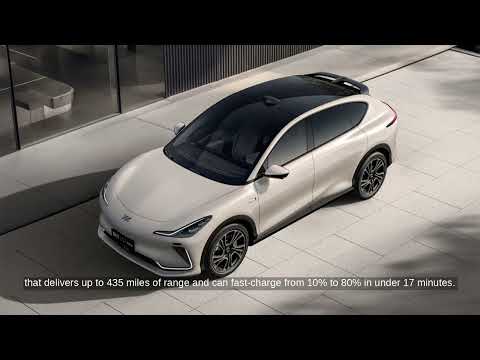Refreshed IM LS7 Debuts with Advanced Four-Wheel Steering and Upgraded Features
The 2026 IM LS7, an all-electric mid-size crossover from IM Motors, a premium EV brand under SAIC, has been unveiled with significant updates, including a new intelligent four-wheel steering system. Launched initially in February 2023, the LS7 aims to bolster its position in China’s competitive EV market with enhanced technology, improved range, and a refreshed design. Here’s a detailed look at the revamped model.
Intelligent Four-Wheel Steering
The standout feature of the 2026 IM LS7 is its intelligent four-wheel steering system, a first for the model. This system enhances maneuverability by allowing the rear wheels to turn up to 5 degrees in the opposite direction of the front wheels at low speeds, reducing the turning radius to 4.8 meters—ideal for tight urban environments. At higher speeds, the rear wheels align with the front wheels for improved stability during lane changes or cornering. The system adapts to various driving scenarios, offering three steering modes: Urban, Standard, and Sport. These can be customized via the vehicle’s settings for a tailored driving experience.
Powertrain and Performance
The refreshed LS7 retains its robust electric powertrain, available in single-motor rear-wheel-drive (RWD) and dual-motor all-wheel-drive (AWD) configurations. The RWD model delivers 340 horsepower and 391 lb-ft of torque, while the AWD variant boosts output to 558 hp and 535 lb-ft, achieving a 0-60 mph sprint in approximately 4.5 seconds. Both versions use a 90-kWh ternary lithium battery, offering a CLTC range of up to 415 miles for the RWD model and 385 miles for the AWD, a slight improvement over the previous model’s 404 and 375 miles, respectively. Real-world EPA estimates would likely be closer to 330–350 miles.
The LS7 now supports 150 kW DC fast charging, enabling a 10–80% charge in about 25 minutes. A new thermal management system enhances battery performance in cold climates, addressing a common EV pain point.
Exterior and Interior Updates
The 2026 LS7 sports subtle exterior tweaks, including a revised front fascia with sleeker LED headlights and a more sculpted bumper. The aerodynamic profile remains, with a drag coefficient of 0.27, and new 21-inch alloy wheel designs add flair. The side and rear retain the signature floating roof and full-width taillight bar, maintaining its futuristic aesthetic.
Inside, the cabin sees upgraded materials, with premium vegan leather and recycled plastics across all trims. The massive 26.3-inch main touchscreen and 15.5-inch passenger display remain, now powered by a Qualcomm Snapdragon 8295 chip for faster response times. A 12.3-inch digital gauge cluster, wireless Apple CarPlay/Android Auto, and an updated voice assistant with natural language processing enhance connectivity. The “zero-gravity” front seats, adjustable in 14 directions, and a panoramic sunroof with adjustable opacity elevate comfort. Rear legroom and cargo space (exact figures TBD) remain generous, rivaling competitors like the NIO ES6.
Advanced Driver Assistance Systems (ADAS)
The LS7’s IM AD suite has been upgraded with a new lidar sensor, 12 cameras, and 5G connectivity for improved semi-autonomous driving. Standard features include adaptive cruise control, lane-keep assist, blind-spot monitoring, and automatic emergency braking. The system now supports hands-free highway driving and automated parking in complex scenarios, positioning it against rivals like the Xpeng G9. Over-the-air updates ensure continuous improvements to ADAS and infotainment.
Pricing and Market Position
The 2026 IM LS7 is priced between 299,800 and 399,800 yuan (approximately $41,000–$55,000 USD), slightly higher than its predecessor due to the added tech. This pits it against the BYD Yangwang U7, NIO ES6, and Zeekr 001 in China’s premium EV segment. While IM Motors focuses on the Chinese market, whispers of global expansion (potentially to Europe) persist, though no concrete plans have been confirmed.
Pros
- Intelligent four-wheel steering enhances agility and stability
- Improved range (up to 415 miles CLTC)
- Faster 150 kW charging
- Luxurious, tech-packed interior
- Advanced ADAS with lidar and 5G
- Competitive pricing for the segment
Cons
- Limited global availability (China-focused)
- EPA range may fall short of CLTC estimates
- Faces fierce competition from NIO, Xpeng, and BYD
- Incremental exterior updates may not excite all buyers
Verdict
The 2026 IM LS7 builds on its predecessor’s strengths with a smarter four-wheel steering system, longer range, and cutting-edge tech, making it a formidable player in China’s premium EV crossover market. Its blend of performance, luxury, and advanced driver aids positions it as a strong alternative to NIO and Xpeng offerings. However, its China-centric availability limits its global impact, and real-world range may not fully match CLTC claims. For Chinese buyers seeking a high-tech, stylish EV, the refreshed LS7 is a compelling choice when it hits showrooms in July 2025.
Other Videos
-
32
-
0
-
0
- New Electric Vehicles
- •
- 13th Jun, 2025
-
102
-
0
-
0
-
63
-
0
-
0
- New Electric Vehicles
- •
- 9th Jun, 2025
-
67
-
0
-
0
- New Electric Vehicles
- •
- 2nd Jun, 2025
-
143
-
0
-
0
- EV Market News
- •
- 27th May, 2025
-
91
-
0
-
0
- New Electric Vehicles
- •
- 23rd May, 2025
-
258
-
0
-
0
- New Electric Vehicles
- •
- 19th May, 2025
-
287
-
0
-
0
- Technology
- •
- 18th May, 2025
-
160
-
0
-
0
- Technology
- •
- 18th May, 2025
-
343
-
0
-
0
- Technology
- •
- 5th May, 2025
-
162
-
0
-
0
- Technology
- •
- 5th May, 2025
-
197
-
0
-
0
- Technology
- •
- 20th Apr, 2025
-
236
-
0
-
0
- General
- •
- 18th Apr, 2025
-
349
-
0
-
0


